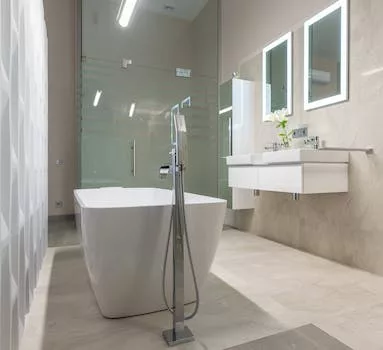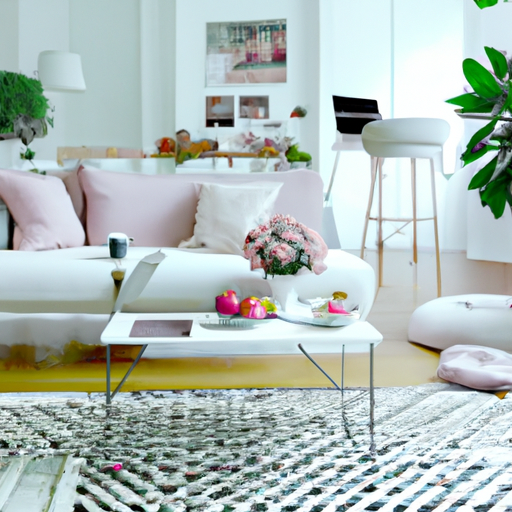Discovering Your Unique Interior Design Aesthetic
Designing a home that reflects your personal style can be a rewarding and fulfilling experience. It allows you to create a space that is uniquely yours, where you can feel comfortable and at ease. However, discovering your unique interior design aesthetic can be a challenging process, especially with the plethora of design styles and trends available today. This article aims to guide you through the process of discovering your unique interior design aesthetic and provide tips on how to design a home that reflects your personal style.
The first step in discovering your unique interior design aesthetic is to take a moment to reflect on your personal tastes and preferences. Consider the colors, textures, and patterns that you are drawn to, as well as the types of furniture and accessories that you find appealing. It can be helpful to create a mood board or Pinterest board to collect images of spaces and items that resonate with you. This will help you identify common themes and elements that can serve as the foundation for your personal design style.
Another important aspect of discovering your unique interior design aesthetic is to consider your lifestyle and the functionality of your space. Think about how you use your home and the activities that take place in each room. This will help you determine the types of furniture, storage solutions, and layout that will best suit your needs. For example, if you enjoy hosting dinner parties, you may want to prioritize a spacious dining area and invest in a large dining table and comfortable seating. On the other hand, if you prefer quiet evenings at home, a cozy reading nook or a comfortable living room with ample seating may be more important to you.
Once you have a clear understanding of your personal tastes and the functionality of your space, you can begin to explore different design styles and trends. There are countless design styles to choose from, ranging from traditional and classic to modern and minimalist. Some popular design styles include Scandinavian, mid-century modern, bohemian, and industrial. It’s important to remember that you don’t have to strictly adhere to one specific style; you can mix and match elements from different styles to create a unique and cohesive look that reflects your personal taste.
When selecting furniture and accessories for your home, it’s important to prioritize quality and craftsmanship. Investing in well-made, timeless pieces will not only enhance the overall aesthetic of your space but will also ensure that your home remains stylish and functional for years to come. Additionally, incorporating unique and personal touches, such as family heirlooms, artwork, or travel souvenirs, can help to create a space that truly reflects your personal style and tells your story.
Finally, don’t be afraid to take risks and experiment with different design elements. Designing a home that reflects your personal style is an ongoing process, and your tastes and preferences may evolve over time. By remaining open to new ideas and trends, you can continue to refine your unique interior design aesthetic and create a space that is truly your own.
In conclusion, discovering your unique interior design aesthetic involves a combination of self-reflection, consideration of your lifestyle and the functionality of your space, and exploration of different design styles and trends. By taking the time to understand your personal tastes and preferences, prioritizing quality and craftsmanship, and incorporating unique and personal touches, you can design a home that truly reflects your personal style. Remember to remain open to new ideas and trends, and don’t be afraid to take risks and experiment with different design elements. With patience and persistence, you can create a space that is uniquely yours and serves as a sanctuary for years to come.
Incorporating Personal Touches in Your Home Decor

Designing a home that reflects your personal style is an exciting and fulfilling process. It allows you to create a space that is uniquely yours, showcasing your tastes, preferences, and personality. Incorporating personal touches in your home decor is essential in achieving this goal. This article will provide you with valuable tips and insights on how to design a home that truly reflects your personal style.
To begin with, it is important to identify your personal style. This can be achieved by taking inspiration from various sources such as magazines, websites, and social media platforms like Pinterest and Instagram. You can also visit furniture stores and showrooms to get a feel of different styles and designs. Once you have a clear understanding of your preferences, you can start incorporating them into your home decor.
One of the most effective ways to add personal touches to your home is by displaying items that hold sentimental value. These can include family heirlooms, photographs, and souvenirs from your travels. By showcasing these items, you not only create a unique and personal space but also evoke fond memories and emotions. Additionally, you can use these items as conversation starters when hosting guests, allowing them to get a glimpse of your personality and experiences.
Another way to incorporate personal touches in your home decor is by choosing furniture and accessories that reflect your taste and preferences. For instance, if you have a penchant for vintage items, you can opt for antique furniture pieces and accessories that exude a sense of history and charm. On the other hand, if you prefer a more modern and minimalist aesthetic, you can choose sleek and contemporary furniture designs. The key is to select pieces that resonate with your personal style and create a cohesive look throughout your home.
Color plays a significant role in setting the tone and mood of a space. Therefore, it is essential to choose a color palette that reflects your personality and preferences. If you are drawn to bold and vibrant hues, you can incorporate them into your home decor through accent walls, furniture, and accessories. Alternatively, if you prefer a more subdued and calming ambiance, you can opt for neutral shades and pastel colors. Remember to maintain a balance between your chosen colors to create a harmonious and visually appealing space.
Incorporating personal touches in your home decor also involves paying attention to the smaller details. This can include selecting unique and eye-catching hardware for your cabinets and doors, choosing decorative light fixtures that complement your style, and incorporating patterned textiles such as rugs, curtains, and cushions. These elements, though seemingly insignificant, can greatly enhance the overall aesthetic of your home and make it truly reflective of your personal style.
Lastly, it is important to remember that your home should be a reflection of your evolving tastes and preferences. As such, do not be afraid to experiment with different styles, designs, and color schemes. You can also update your home decor by incorporating new trends and ideas that resonate with your personal style. This will ensure that your home remains a true reflection of your personality and continues to be a space that you love and cherish.
In conclusion, designing a home that reflects your personal style involves incorporating personal touches in your home decor. This can be achieved by showcasing sentimental items, choosing furniture and accessories that resonate with your preferences, selecting a color palette that reflects your personality, and paying attention to the smaller details. By following these tips and insights, you can create a unique and personal space that truly represents who you are.
Balancing Functionality and Style in Your Living Space
Designing a home that reflects your personal style is an exciting and rewarding process. It allows you to create a living space that is not only functional but also a true reflection of your personality and taste. However, striking the right balance between functionality and style can be challenging, especially when you have to consider various factors such as space constraints, budget, and the needs of your family members. In this article, we will discuss some tips and strategies to help you design a home that is both stylish and functional.
First and foremost, it is essential to identify your personal style. This can be achieved by taking inspiration from various sources such as magazines, websites, and social media platforms like Pinterest and Instagram. You can also visit furniture stores and showrooms to get a feel of different styles and materials. Once you have a clear idea of your preferred style, it becomes easier to make informed decisions about the design elements that will best suit your home.
Next, consider the layout and flow of your living space. A well-designed layout not only maximizes the available space but also ensures that the different areas of your home serve their intended purpose. For instance, the living room should be spacious enough to accommodate seating arrangements for your family and guests, while the kitchen should be designed to facilitate efficient meal preparation and cooking. It is also important to consider the placement of windows and doors, as they can significantly impact the overall functionality and aesthetics of your home.
When selecting furniture and décor items, prioritize quality over quantity. Investing in high-quality pieces that are durable and timeless will not only save you money in the long run but also contribute to a more cohesive and sophisticated look. Additionally, choose furniture that is versatile and can serve multiple purposes. For example, a stylish ottoman can double as a coffee table or extra seating when needed.
Incorporating storage solutions into your design is another crucial aspect of balancing functionality and style. Clutter can quickly detract from the overall aesthetics of your home, so it is essential to have ample storage options to keep your living space organized and tidy. Consider built-in storage solutions such as shelves, cabinets, and closets, as they can seamlessly blend with your home’s design while providing much-needed storage space.
Color plays a significant role in setting the mood and tone of your living space. To create a harmonious and visually appealing environment, choose a color palette that complements your personal style and the overall design of your home. You can use neutral colors as a base and then add pops of color through accent pieces such as throw pillows, artwork, and rugs. This approach allows you to easily update your home’s look without having to completely overhaul the design.
Lastly, do not be afraid to personalize your living space with unique and meaningful items. Displaying family photos, travel souvenirs, and artwork that holds sentimental value can add warmth and character to your home. These personal touches not only make your living space more inviting but also serve as a reflection of your personality and experiences.
In conclusion, designing a home that reflects your personal style requires careful planning and consideration of various factors such as layout, furniture selection, color schemes, and storage solutions. By striking the right balance between functionality and style, you can create a living space that is not only visually appealing but also serves the needs of your family. Remember to take your time, gather inspiration, and most importantly, have fun with the process. Your home should be a sanctuary that brings you joy and comfort, and there is no better way to achieve this than by infusing it with your unique style and personality.
Q&A
Question 1: How can I identify my personal style for designing my home?
Answer: To identify your personal style, start by browsing through interior design magazines, websites, and social media platforms like Pinterest to gather inspiration. Take note of the colors, patterns, and materials that resonate with you. Consider your lifestyle, hobbies, and preferences to create a list of elements that define your style, such as minimalism, bohemian, or industrial.
Question 2: How can I incorporate my personal style into my home design?
Answer: To incorporate your personal style into your home design, choose a color palette that reflects your preferences and use it consistently throughout your home. Select furniture and decor pieces that align with your style, and don’t be afraid to mix and match different elements to create a unique look. Personalize your space with artwork, photographs, and accessories that hold sentimental value or represent your interests.
Question 3: How can I maintain a cohesive design while incorporating my personal style?
Answer: To maintain a cohesive design, establish a consistent color scheme and stick to a few key design elements that represent your personal style. Use similar materials, textures, and patterns throughout your home to create a sense of harmony. Additionally, maintain a balance between statement pieces and more subtle decor to avoid overwhelming the space.
Conclusion
In conclusion, designing a home that reflects your personal style involves understanding your preferences, researching various design styles, incorporating meaningful elements, and maintaining a balance between aesthetics and functionality. By carefully selecting colors, materials, furniture, and accessories that resonate with your personality, you can create a living space that is both visually appealing and uniquely yours.


